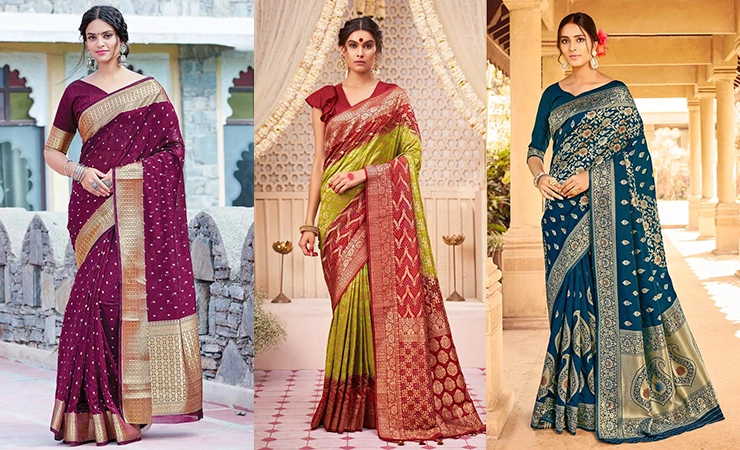
India, a nation steeped in cultural diversity, boasts a rich variety of traditional clothing that tells the story of its history, customs, and connection with art. Indian fashion, with its vibrant colors and intricate craftsmanship, has captured the admiration of the world, so in our today’s guide, we’ll explore the most distinctive pieces of traditional Indian clothing, each contributing to the country’s unique sartorial narrative.
Saree
Saree (sometimes also spelled as “Sari” in the Western cultures), a timeless and elegant garment, is a six to nine-yard piece of fabric that graces the feminine form with unmatched beauty. Draped in various styles across regions, the saree showcases exquisite weaving and embroidery techniques. Whether it’s the opulent Banarasi silk, the vibrant Kanjeevaram, or the delicate Chikankari, each saree variety is a testament to India’s rich textile heritage.
Salwar Kameez
Salwar kameez, a classic ensemble, consists of loose-fitting trousers (salwar), a tunic-length top (kameez), and a flowing scarf or dupatta. This versatile outfit ranges from everyday cotton suits to intricately embroidered Anarkali suits, combining comfort with style. The hand-embroidery, beadwork, and vibrant prints make the salwar kameez a staple in every Indian woman’s wardrobe.
Churidar
Churidar, characterized by tightly fitting trousers that gather at the ankle, is often paired with the traditional kurta. This ensemble radiates simplicity and grace, making it a popular choice for both casual and formal occasions. The churidar’s streamlined silhouette allows for ease of movement, providing both comfort and elegance.
Lehenga Choli
Lehenga choli, a symbol of opulence, comprises a flared skirt (lehenga), a fitted blouse (choli), and a flowing dupatta. Adorned with intricate embroidery, sequins, and mirrors, the lehenga choli is the epitome of bridal and festive wear. Regional variations like the Rajasthani lehenga and the Gujarati chaniya choli showcase India’s diverse cultural influences.
Anarkali
Anarkali suit, named after the legendary dancer Anarkali, features a long, frock-style kurta paired with fitted bottoms. This outfit’s flair and elegance make it a popular choice for weddings and special occasions. The Anarkali suit, with its voluminous silhouette and intricate detailing, pays homage to the Mughal era’s grandeur.
Dhoti
A traditional men’s garment, the dhoti is an unstitched piece of cloth wrapped around the waist. Paired with a kurta or shirt, the dhoti is a symbol of simplicity and sophistication. Worn during religious ceremonies and festivals, the dhoti reflects a deep connection to India’s cultural roots.
Lungi
Lungi, a comfortable and casual garment, is a rectangular piece of cloth worn as a lower garment by men. Popular in South India, the lungi is versatile and well-suited for the country’s warm climate. Its ease of wear and vibrant patterns make it a common choice for daily activities.
Angarkha
Angarkha, a traditional layered garment, features a cross-over style with ties or fastenings on the side. Often worn by men, the Angarkha showcases intricate embroidery and detailing. This classic piece evokes a sense of regality and is commonly worn during cultural events and celebrations.
The post Complete Guide to Indian Clothing appeared first on The Fashiongton Post.
